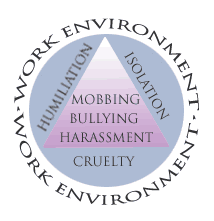| This book has held its own since its first printing in May of 1999. Though more research exists today validating and expanding the knowledge about mobbing/bullying as an insidious workplace phenomenon, the history of the concepts, the definitions, the description of the impact and immense costs to individuals and organizations, and our call to action are as relevant now as they were some years ago.We still get countless messages of thanks and expressions of great relief from readers who discover that they are not alone and that what they are experiencing is a known workplace phenomenon. Our book has helped them to understand that this vicious social elimination process is not about them. That it is a human behavior that needs to be recognized and responded to with understanding, insight, leadership, training, structures, policies and laws that encourage people in organizations to behave with decency.
The stories we hear do not change. A comment we receive frequently is: You’ve captured my story. It’s as if you’ve followed me around. We had hoped to assist people most of all in their quest for clarity and out of confusion, bitterness, or despair. And we are grateful that we succeeded. The book is still being used as a textbook in various college courses across the country. And it continues to be cited in new publications dealing with work harassment, the drudgery of work or bully bosses. Even a novel The Teasdale Primer (for MBAs) references the book. In addition to the Japanese edition, our book has also been published in Turkey. We refer the reader to our website www.mobbing-usa.com for updates and further references, especially with regard to developments on the legal front and newer research regarding prevalence. Nevertheless, we would like to point to some modest yet encouraging developments. Various bills have been introduced in California, Hawaii, Oklahoma, Oregon and Washington, although none has been successful to date. In Massachusetts in November of 2004, voters in the Amherst legislative district approved a ballot question instructing their representative to introduce legislation to declare workplace harassment a public health hazard and to do a statewide study of bullying and harassment at work. (1) In Quebec, Canada, the Labour Standard A Work Environment Free From Psychological Harassment was adopted in 2004. (2) In terms of recent legal analysis in the U.S. we point to Brady Coleman’s article Pragmatism’s Insult: The Growing Interdisciplinary Challenge to American Harassment Jurisprudence. (3) Today, we know more about the prevalence of the phenomenon. The data vary a great deal as different researchers use different definitions. For example, two studies suggest that 18% or 70% respectively of the US workforce experienced bullying behaviors. (4) The newest research regarding prevalence that has come to our attention is Pamela Lutgen-Sandvik et al., Workplace Bullying in the United States: Incidence, Comparison to International Research and a Delineation of Bullying “Degree.” (5) These authors operationalized our three degrees of mobbing/bullying impact and created a study to give this concept a scientific base. And those interested in academic mobbing will rejoice in knowing that what was announced in 2002 was published in 2004: two more books, one written and one edited, by Kenneth Westhues. Both are the most comprehensive and detailed analyses of the mobbing process in academia existing in print. Administrative Mobbing at the University of Toronto: The Trial, Degradation and Dismissal of a Professor During the Presidency of J. Robert S. Prichard, and Workplace Mobbing in Academe: Case Studies and Analyses. (6) U.S. authors generally prefer the term bullying. As we stated in the book, the concepts of mobbing and bullying blur. We maintain that mobbing captures the group process and the social mentality more than the focus on one person’s behaviors. Moreover, bullying is traditionally linked to a school setting. Because mobbing, in our understanding, has very much to do with the psychology of group spirit and group action, it would also be a more descriptive term to be used in schools. And, contrary to the workplace, awareness, literature, and policies focusing on school bullying abound. Yet, what ultimately counts is that awareness has been raised, no matter what definitions or concepts scholars choose. And that more authors publish books about this phenomenon, that journalists keep writing stories, that organizations respond by requesting training, that lawyers begin to understand and use the concepts, that legislators take the issue seriously and, above all, that targets heal and begin to tell their stories publicly, and contribute to positive action and change. Preface Endnotes
|





